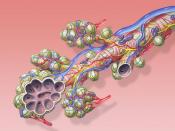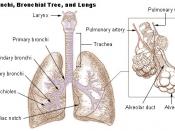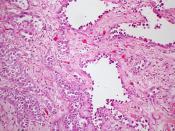Respiratory Function / Dysfunction
This paper shall seek to describe the structure and function of the lungs. It will also explain the effect of asthma on the lungs, and the consequences of a dysfunction of the respiratory system. A range of treatment responses including the main treatment for asthma, in minimizing this dysfunction of the respiratory system shall also be discussed and how asthma can be prevented.
The human respiratory system is made up of the lungs and the system of air tubes that carry oxygen (air) to and from the lungs, the respiratory system is separated into two major parts, the upper airway and the lower airway. The upper airway works to move air to the lower airway. The upper airway consists of the nasal cavity (nose), air is drawn through the nostrils into the body, where it is warmed and moistened. The walls of the nasal cavity have a carpet of tiny hair-like bristles called Cilia, that sweep debris and mucus upward, so that it is swallowed or coughed out.
Other cells, called Goblet cells, line the airways and secrete sticky mucus to trap dust or other particles. The consistent sweeping motion of the cilia filter out debris so when oxygen finally reaches the tiny alveoli, in the lungs, it is clean. The nasal passages are also responsible for the sense of smell. After the nasal passages, the air travels through the pharynx (throat) then on to pass through the larynx (voice box). The larynx runs directly into the trachea (windpipe) and is the connection between the upper airway and the lower airway. There are C-shaped cartilage which surrounds these airways, they hold the trachea permanently open, causing them to expand when breathing in and relax when breathing out. These also prevent the trachea from being blocked by...


